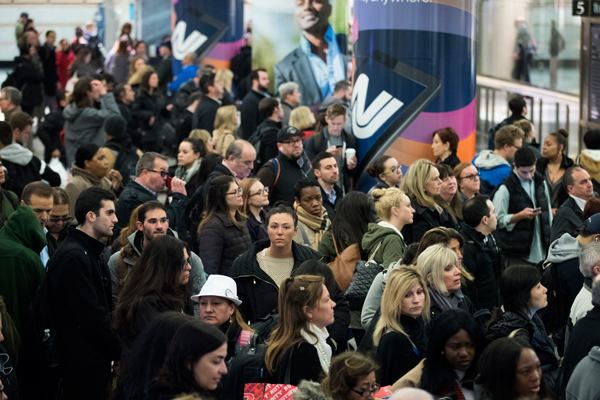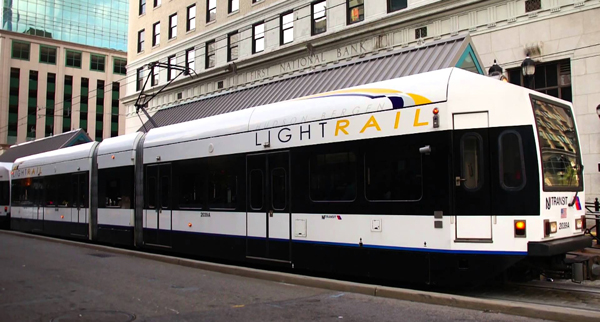Trending
Infrastructure meltdown?
Projects like Gateway could bring many of new buyers and renters to North Jersey, but funding remains a giant question mark

New Jerseyans commuting to and from Penn Station this summer may begin to question the value of living in the prized neighborhoods that bill themselves as “convenient” to New York City. Two train derailments within 11 days this spring — one of which forced the closure of eight of Penn Station’s 21 aging tracks, creating a ripple of delays for Jersey and Long Island commuters alike — finally brought an urgency to the transit hub’s long-deteriorating condition. Amtrak announced that several tracks out of Penn will be closed over the summer for repairs, and commuters are bracing for major delays.
But just three blocks west of there, weeks after the highly publicized April 3 derailment, Amtrak Chairman Tony Coscia waxed optimistic about the rail line’s expansion.
Standing inside the LIRR storage facility in Hudson Yards, Coscia — hard hat and all — pointed to the ground. Seventy-five feet beneath him, he told a group of reporters, the construction of two single-track rail tubes was underway — the first phase of the beleaguered Gateway tunnel project.
“I’m not at all upset about commuters who are upset. They should be upset,” Coscia told The Real Deal.
But angry commuters and piecemeal track repairs are the least of his problems. Gateway’s project partners, which include the Port Authority and New Jersey Transit, have secured only a fraction of the $20 billion needed in funding. The federal government’s contribution remains in question, since it’s unclear whether President Obama’s approval of the project will be rubber-stamped by the Trump administration.
Gateway is by far New Jersey’s most important infrastructure project, experts say. Beyond connecting commuters to their work, “Gateway will have a monumental effect on North and Central New Jersey, because what it’s doing is preserving the economic value of those areas,” said Martin Robins, who helped shape the New Jersey Transit system and is the founding director of the Alan M. Voorhees Transportation Center at Rutgers University.
The project also has great potential to catapult real estate values around New Jersey Transit stations, brokers say. That is, if it ever reaches completion — a formidable task, considering Jersey’s track record in completing infrastructure undertakings.
“There’s no doubt that Gateway will be significant here,” said Bruce Elia Jr., a Keller Williams broker based in Fort Lee. “Fifty percent of the population within a mile from the Hudson work in New York City. Having transit would mean less congestion, and people don’t want to drive.”
In other words, Gateway could bring forth even greater migration from across the river. “Our buyers right now are complaining about how NJ Transit is not being very efficient,” said Arlene Gonnella, a broker with Weichert Realtors in Short Hills. “At least for homes located within walking distance of a station, Gateway will without a question be good for the market.”
But the project’s real estate champions may be getting ahead of themselves. Gateway is only about 20 percent funded, while the rest remains up in the air.
“There’s no way that this should be done without private capital, and there’s no way it can be done without public capital,” Coscia said.
Such is the conundrum for the handful of other major New Jersey infrastructure projects, most of which would have a positive effect on Northern New Jersey real estate, if they ever get done. As vital public transit infrastructure is falling into dangerous disrepair, who will pay to fix it?
For projects like Gateway and the redevelopment of Midtown Manhattan’s Port Authority terminal for New Jersey Transit buses, New York and New Jersey play a game of hot potato: New York has historically seen commuter transit as New Jersey’s responsibility, while New Jersey argues that the commuters pay tax in New York and should benefit from those contributions, Philip Plotch, the director of the public administration program at Saint Peter’s University, said.
“No one really makes money on public transportation,” Plotch, a former transportation planner in New York, told TRD.

The Hudson-Bergen Light Rail expansion plans could bring seven new stations.
As financing for the Gateway project remains in question, so too does the source of capital for the aging Port Authority bus terminal. In the spring, the Port Authority of New York and New Jersey approved $3.5 billion for the project in its 10-year capital plan, but debate continues as to whether the current terminal should undergo renovations and expansion or if it should be completely replaced, which would bring the price tag up to $10 billion. The Port Authority acknowledged that private capital would be required no matter how the project takes shape.
Janna Chernetz, director of New Jersey policy at the Tri-State Transportation Campaign, isn’t optimistic about the project’s future.
“A [new] bus terminal?” she said, with a bit of a laugh. “There’s been no progress. We are certainly nowhere near having a new terminal, at least not in the next 10 years.”
Beyond the commuter projects, infrastructure statewide is in disrepair. The American Society of Civil Engineers gave New Jersey a grade of D+ for the state of its infrastructure overall. It’s the same score the entire U.S. received.
“The highways and bridges are maxed out, the train lines are maxed out, and the bus terminals are maxed out,” Plotch said.
But some of New Jersey’s roads and bridges will soon get their well-deserved overhaul. Last October, Gov. Chris Christie signed into law a long-awaited transportation funding package that will raise New Jersey’s gasoline tax by 23 cents, generating $400 million to replenish the state’s Transportation Trust Fund (TTF).
About $260 million will be directed toward roads and bridges, while $140 million will go to NJ Transit services. The bulk of the money will be devoted to North and Central Jersey counties, the appropriation list shows.
The tax money that funds the plan, however, was a long time coming. Christie made waves last year when he effectively froze all activity funded by the TTF in June 2016 — halting all state and municipal roadwork that was supported by the fund — because the state Senate refused to vote on his gas tax increase, which at the time came with a one-cent reduction in the sales tax.
The tough negotiating tactics led to a win for the state’s infrastructure, but if there is one cardinal sin the governor has committed in his tenure (though some would argue there were many more), it was his cancellation of the ARC, or the Access to the Region’s Core project, experts say.
The predecessor to Gateway, ARC was an $8.7 billion tunnel project that would’ve have created new tracks, a rail yard, a tunnel under the Hudson and a new station adjacent to the ailing Penn Station. Construction began in 2009, and by 2010, $600 million had already been spent. But in October 2010, Christie canceled it, claiming that it would cost more than projected and that the state didn’t have the money.
The federal Government Accountability Office investigated Christie’s claims the following year and found that he had misrepresented the scope of potential overruns in cost as well as New Jersey’s obligation to pay them.
“If it hadn’t been canceled, it’d be almost done today,” said Robert Noland, director of the Voorhees Transportation Center.
Proponents of ARC claimed that the project would’ve drastically raised real estate values close to the train. A 2010 report from the Regional Planning Association projected that the ARC would have raised the value of homes by $19,000 on average if they were within two miles of the train stations and by $29,000 for those within walking distance.
“If you look at new light rail stations pretty much anywhere in the country, property values around them increase the following year,” Elia said.
Below, TRD breaks down the smattering of infrastructure projects the state is currently pursuing that could impact the real estate market.
Penn Station repairs
Several Amtrak tracks will close for nearly three weeks in July and almost the entire month of August. Amtrak told passengers that they should expect delays of up to 30 minutes during maintenance periods.
The issue with such repairs, according to Art Guzzetti of the American Public Transportation Association, is that the undertaking would’ve been much easier had it been pre-emptive.
“The core of a lot of the problems is that you need to be looking ahead and not let it fall to backlog,” Guzzetti, a former NJ Transit executive who helped create the agency, said.
“Right now, [they’re] in this catchup mode” — and it’s a lot more expensive than if the right people made the right investments decades ago, he added.
Coscia acknowledges the broader impact of Amtrak’s maintenance. “The way we manage all of this will play a major role in whether you can sustain real estate values in and around New York City,” he said. “What’s the value of a building, whether it’s commercial office space, residential, retail, if you can’t generate access to it?”
Port Authority Bus Terminal
The Port Authority terminal expansion would ease the growing congestion that the station currently endures. The big problem is the lack of room — there’s not enough space for the incoming buses and not enough room for the commuters. The expansion may require the creation of a new station and could cost around $10 billion.
Some critics say revamping the old station isn’t necessary: The agency would be better served by constructing a smaller terminal in Manhattan as well as one on the New Jersey side of the river and connecting it to Manhattan via subway.
Hudson-Bergen Light Rail expansion
The project with likely the most immediate impact on the real estate market would be the extension of the Hudson-Bergen Light Rail into Bergen County. Initially proposed in 2001, the train line’s stretch into Bergen County has been delayed for years. Last fall, the State Assembly approved a bill to add seven stations in an expansion northward into Englewood, which is now in the public hearing phase of planning.
Estimated to cost around $1 billion, the project would likely provide an economic boost to not only Bergen County but also the communities linked to it by train. The existing Hudson-Bergen line has already increased housing values in Hudson County and catalyzed development in Morristown, Madison and South Orange, according to a study by Rutgers economist Michael Lahr.
“Because of the Hudson-Bergen Light Rail, there is now a staggering amount of development and new projects that have occurred in the last decade around the stations in Hoboken, Jersey City, and Weehawken,” Robins said. “It’s been remarkable.”
PATH train extension
The bistate commission recently authorized $57 million in spending on preliminary design work and an environmental study for the extension of the PATH train to Newark Liberty International Airport, a project that would eventually cost around $1.7 billion.
The extension would measure 2.4 miles and link PATH riders from several stops in New Jersey and lower Manhattan to a new station at the airport. Because the station will have a park-and-ride facility as well, residents in counties like Essex and Union will have another way to get into Manhattan.
Not everyone is on board, however.
“We would not characterize the PATH extension to Newark Airport as an important project, considering the existing capacity,” Chernetz of the Tri-State Transportation Campaign said.
7 line extension into Secaucus
This project has been in talks for years, with no momentum thus far. Last September, the Port Authority released a report claiming that extending the 7 train to New Jersey would be “the one major trans-Hudson investment that studies suggest could significantly reduce long-term bus terminal demand.”
According to a study commissioned by New York City in 2013, a 7 train to Secaucus would accommodate an additional 128,000 passengers every day.
But like the Port Authority bus terminal expansion, it’s unclear where the funding would come from. Authorities say a new subway tunnel would cost billions, and even then, the Port Authority still needs a new bus terminal.




